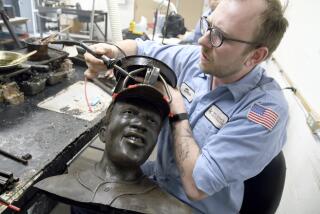After Fall, Adam Won’t Be the Same, Expert Contends
- Share via
After singing the nursery rhyme about how Humpty Dumpty could never be put together again, a leading Renaissance scholar said Wednesday that a priceless marble sculpture of Adam by the Venetian sculptor Tullio Lombardo will never recover fully from a fall Sunday at the Metropolitan Museum of Art in New York.
The piece was “the country’s most important Renaissance sculpture, unfortunately,” said Colin Eisner, a professor of fine arts at New York University who works across Fifth Avenue from the Met.
Once damaged, a work of art “is not the same,” he said.
Lombardo lived circa 1455 to 1532, and the sculpture is dated 1490-95. Standing 6-foot-3, it depicts a youthful Adam standing, his arm resting on a tree trunk. The museum acquired it in 1936.
The statue is valued as the first monumental nude of the Renaissance, reviving the idealized forms of Greek and Roman art. It was on a 4-foot-tall plywood base just 3 years old that apparently buckled without provocation. The accident caused extensive damage to the figure’s arms and legs as well as to the tree trunk; the head and torso were relatively unharmed, officials said. One local preparation specialist--an expert in packing and shipping similar sculptures--estimated that the piece weighs 1,800 pounds.
Eisner, who has written extensively on Michelangelo, compared the damage to that suffered by Michelangelo’s famous Pieta, which underwent extensive repair after being attacked in 1972 by a vandal with a sculptor’s hammer.
“It has a kind of cosmetic appearance where it’s been restored,” Eisner said of Michelangelo’s marble depiction of Mary and Jesus, displayed in St. Peter’s Basilica in Rome. The vandal severed Mary’s arm at the elbow, took a chunk off her nose and chipped one of her eyelids. “Because it’s marble, even if they use an almost invisible adhesive, it looks cosmetic.”
If scholars doubt that Lombardo’s Adam can be fully restored, those who do the work are more optimistic. They agree with Metropolitan museum director Philippe de Montebello’s prediction that after repair--expected to take two years--only the “cognoscenti” will recognize a change.
“The fact they are clean breaks is a plus,” Virginia Greene, a leading sculpture conservator at the University of Pennsylvania, said Wednesday. “And there has been no previous repair, no adhesives, no messing around with the joins.” (Joins are areas where two pieces of marble meet.)
She cautioned that “depending on the nature of the stone, it is difficult to tell how invisible the repairs will be.” But she added: “I would expect that the results would be pretty good.
“The greatest difficulty will be areas where the marble has powdered on impact. This will have to be done with fills. There are, however, modern resin-based fill materials which mimic the translucency of marble,” Greene said. “So the possibilities are really quite good that the results will be entirely satisfactory.”
Areas that have been repaired will be visible with an ultraviolet light, she said, but likely not noticeable to most observers. Harold Holzer, the Metropolitan Museum’s chief spokesman, said the sculpture was discovered shattered after 9 p.m. Sunday by a guard making routine rounds.
On Monday and much of Tuesday, museum staff gathered the broken pieces. As each shard was retrieved, it was bagged, numbered and identified. The torso was later taken to the museum’s conservation laboratory. “At the same time this was happening, an assessment of the pedestal was made, which was clearly, as far as we can tell, the area of the problem,” Holzer said. One side of the base had collapsed.
Holzer said sculpture bases throughout the museum were being reinforced and rechecked for safety. Conservators and museum professionals around the country said they were doing the same at their institutions.
“It’s certainly a wake-up call for many institutions,” said Victoria Blyth-Hill, director of the conservation center at the Los Angeles County Museum of Art. “You can’t take these things for granted.”
Because of earthquake dangers, Los Angeles museums already are very cautious about securing objects, making fluke accidents like the one at the Metropolitan unlikely here. “I am happy to say that we are so careful,” said Brian Considine, conservator of decorative arts and sculpture at the J. Paul Getty Museum. “Because the forces that an object or a pedestal would experience under dynamic loading in an earthquake situation are so much greater than the static loads, we really overbuild things. We prepare for the worst.
“We are already doing the kinds of things the Met might think about doing now.”
More to Read
The biggest entertainment stories
Get our big stories about Hollywood, film, television, music, arts, culture and more right in your inbox as soon as they publish.
You may occasionally receive promotional content from the Los Angeles Times.










